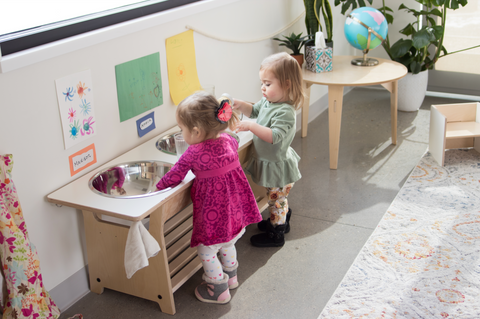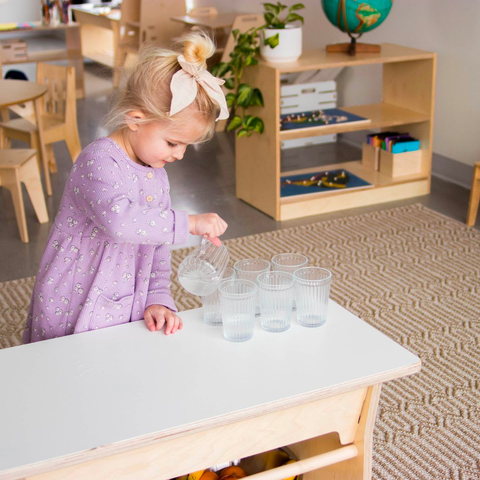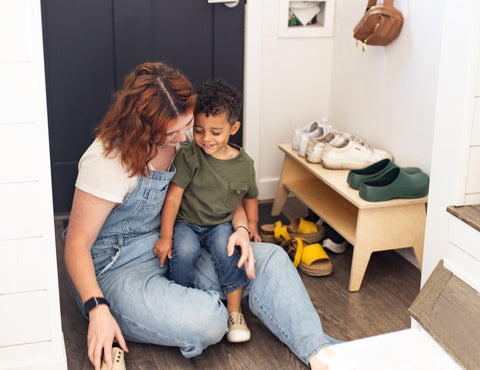What is Practical Life?
In Montessori environments, an essential pillar of the curriculum is an area referred to as "Practical Life." These are the activities of daily life that allow us to function within our environments, such as cooking, cleaning our clothes and our homes, and caring for ourselves. Young children are naturally drawn to these types of activities, and while they may feel like chores to adults, they are most often engaging and exciting to children!

Why Might I Include My Child In Chores?
While it may seem like we’re putting children to work by engaging them in activities like washing dishes, sweeping, and cleaning windows, the goals of the Practical Life area extend far beyond developing a particular life or household skill.
The goals of Practical Life activities are focused more on process than product. Through these activities, children develop coordination of movement, meaning that they hone their fine and gross motor skills, hand-eye coordination and left-to-right tracking, preparing them for reading and writing.
They also develop concentration as they engage in activities that hold their attention for longer and longer periods of time, preparing them for more complex work.
Lastly, they develop independence as they become more and more self-sufficient in their environment! They gradually become aware of the social needs of their community and how they can take a role in contributing.

Areas of Practical Life
The Montessori Primary (3-6) Practical Life curriculum is divided into four categories: preliminary exercises, care of self, care of the environment, and grace and courtesy.
Preliminary Exercises
Preliminary Exercises help children adapt to the classroom environment and expectations when they first arrive. They also provide the foundation for longer and more complex activities. These include activities like opening and closing boxes, folding cloths, pouring, rolling and unrolling a work rug, and putting on an apron. By isolating skills that are part of other activities in the classroom, children have the opportunity to focus on just one challenge at a time and master a skill before engaging in a more complex activity.
Care of Self
Care of Self activities give children independence and autonomy in caring for their growing bodies. These skills help a child to develop not only greater independence, but also foster a sense of self-respect as they take pride in meeting their own needs. In the classroom environment, these activities might include working with the Dressing Frames (wooden frames that isolate common clothing fastenings like a zipper, buckle, snap, and bow ties), hand-washing, hair care, and putting on a coat.
Care of the Environment
Care of the Environment activities engage children in participating in their community, whether it is in the home or the classroom, or another environment of which they are a part. By participating in activities such as washing dishes, preparing food, folding clothes, watering plants, and more, children can feel a sense of belonging and pride in their contributions to their community.
Grace and Courtesy
Grace and Courtesy lessons are given to children in Montessori environments to help them adapt and learn how to “be” in the classroom. These lessons include both physical movements and specific language that children can use. They are given in small groups through modeling, and children get the opportunity to practice at a “neutral” moment when they when they do not need to worry about being corrected.
Examples of physical Grace and Courtesy lessons include tucking in a chair, rolling a work rug, carrying a tray, and walking slowly, while examples of verbal Grace and Courtesy lessons include phrases to say when introducing yourself, apologizing and asking for help.

Practical Life Work at Home
Children can participate in Practical Life work in the home as well!
Preparation of the environment is an important consideration when setting children up for success in practical life work. For example, if children have access to a low drawer with their dish-ware in it, they can set their seat at a low table when preparing for a snack or mealtime. They can then bring their dishes to the sink or load them in the dishwasher with an adult’s help. A Toddler Tower can help bring children to the level of a kitchen counter in order to help with food preparation, while a low bench in an entryway can support children learning to put on their own shoes.
For a list of Practical Life activities by age, see this list from Simone Davies of The Montessori Notebook!
What Practical Life activities does your little one enjoy right now?




